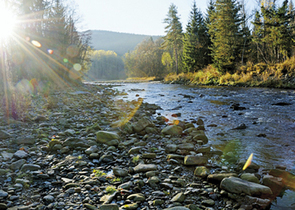The Journal is published by the Nature Conservation Agency of the Czech Republic in cooperation with the Cave Administration of the Czech Republic, the Krkonoše Mts. National Park Administration, the Bohemian Forest Mts. National Park Administration, the Podyjí National Park Administration and the The Bohemian Switzerland National Park Administration. It has been published since 1946.
cs / en
Nature Conservation 6/2008 — 16. 12. 2008 — On Nature in the Czech Republic
The Šumava/Bohemian Forest National Park
It protects the most extensive mountain Norway Spruce forests and mixed mountain forests as well as the moist extensive mountain peat-bogs in the country, the best preserved Central European floodplain (the Vltava River floodplain) and many other significant habitats. At present, approx. 80 % of the whole NP´s territory is covered by forests. Mountain Norway Spruce forests naturally occur at 1,200 – 1,250 m a.s.l. on the Šumava/Bohemian Forest Mts. ridges and plains. Peat-bog and waterlogged Norway Spruce forests as well as Bog Pine growths are azonal continuation of peat bogs. Among non-forest habitats, grassland forestless patches are of the greatest importance, harbouring at least 60 % of the Šumava/Bohemian Forest Mts. total species richness. The National Park includes core parts of distribution ranges in the following four plant endemics: the Mon's Hood (Aconitum plicatum), Bohemian Gentian (Gentianella praecox subsp. bohemica), Black Rampion (Phyteuma nigrum) and Peat-Bog Western Marsh Orchid (Dactylorhiza majalis subsp. turfosa). From a point of view of zoology, the Šumava/Bohemian Forest Mts. is a typical forest middle mountain area which has been hosting original Central European forest fauna. The only large predator there is the Eurasian Lynx (Lynx lynx). In forests at higher elevations, bird species with boreal-montane distribution, e.g. the Capercaillie (Tetrao urogallus), Black Grouse (Tetrao tetrix), Hazel Grouse (Tetrastes bonasia), and other bird species, such as the Three-toed Woodpecker (Picoides tridactylus), Ring Ouzel (Turdus torquatus), Tengmalm´s Owl (Aegolius funereus) and Ural Owl (Strix uralensis) occur. The Šumava/Bohemian Forest National Park was established in1991. Since that time, there have been controversies in forest management, particularly whether the National Park mission should include felling trees affected by the European Spruce Bark Beetle (Ips typographus). In January 2007, hurricane Kyrill caused a considerable damage to forests in Šumava/Bohemian Forest National Park: the total volume of fallen and broken trees reached more than 850,000 m3. While it was decided that on the mountain ridges, gale-disaster areas have been left to natural recovery, at lower elevations and where the National Park borders the forest land owned by private owners, the European Spruce Bark Beetle is controlled to be kept within the NP's territory. Due to the above measures, the European Spruce Bark Beetle affected only less than 1 % of the whole NP´s territory in 2008.
Název připojené galerie
Quisque egestas velit non nulla fermentum, aliquet pharetra nunc malesuada. Nullam molestie vel diam non tincidunt. Sed pulvinar lacinia nunc et consectetur. Duis varius leo ac ex scelerisque, ullamcorper eleifend massa consectetur. Nullam in metus ac arcu pellentesque venenatis ac id lorem. Nulla nec ipsum sed enim sodales blandit a sit amet ex.


